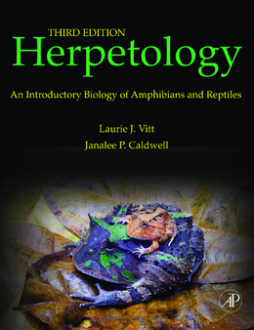
Additional Information
Book Details
Abstract
This third edition, now fully revised and updated by two of Dr. Zug's colleagues, provides herpetology students and amateur reptile and amphibian keepers with the latest taxonomy and species developments from around the world. Herpetology is a rapidly evolving field, which has contributed to new discoveries in many conceptual areas of biology. The authors build on this progress by updating all chapters with new literature, graphics, and discussions—many of which have changed our thinking.
With a new emphasis placed on conservation issues, Herpetology continues to broaden the global coverage from earlier editions, recognizing the burgeoning reptile and amphibian research programs and the plight of many species in all countries and all biomes.
New information on the remarkable advances in behavioral, physiological, and phylo-geographical data provide students with the current research they need to advance their education and better prepare their future in herpetology.
* The latest taxonomy data
* End-of-chapter discussions for classroom use
* 90% new photographs, now all in full color for an enhanced visual representation
* Most recent information on the exciting and developing herpetological communities in Australia, Europe, Asia, South and North Americas
* New emphasis on conservation issues surrounding herpetology
"The volume successfully captures the state of the art in leading research programs on amphibians and reptiles. Professional herpetologists will discover that it is an exemplary teaching resource. This new edition will prove indispensable in courses on herpetology and vertebrate diversity..."--The Quarterly Review of Biology - David C. Blackburn, Natural History Museum & Biodiversity Institute, University of Kansas, Lawrence, KS
"[T]his third edition of a leading herpetology textbook speaks for itself. The study of amphibians and reptiles is revealed as a dynamic field serving as a portal into a diverse range of biological disciplines…. [T]here are now more than 500 figures (an increase of more than 35% over the second edition and more than 320% in the first) and color appears throughout the volume not just in the taxonomic chapters. This alone makes this book an invaluable teaching tool…. The volume successfully captures the state of the art in leading research programs on amphibians and reptiles…. Both undergraduates and beginning graduate students as well as amateurs will find this book to be an engaging entry into the field of herpetology. Professional herpetologists will discover that it is an exemplary teaching resource. This new edition will prove indispensable in courses on herpetology and vertebrate diversity..."--Quarterly Review of Biology
